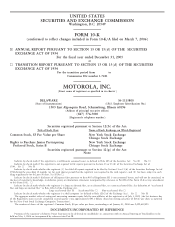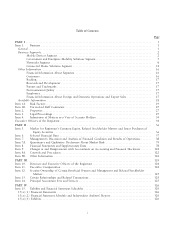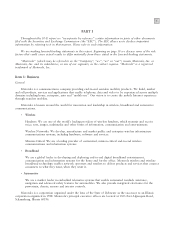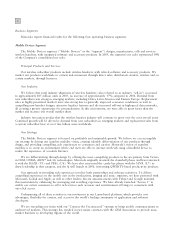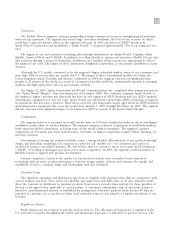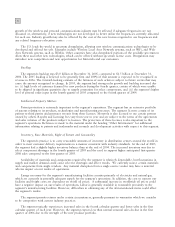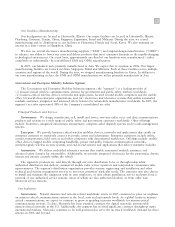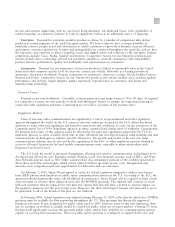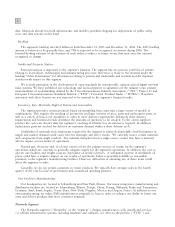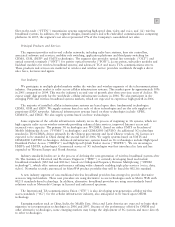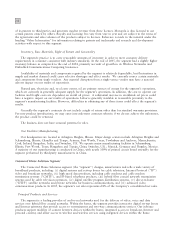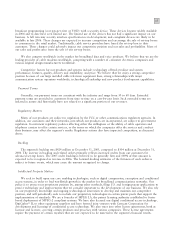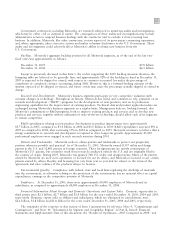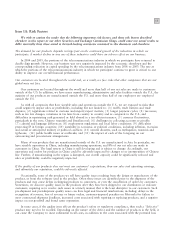Motorola 2005 Annual Report Download - page 16
Download and view the complete annual report
Please find page 16 of the 2005 Motorola annual report below. You can navigate through the pages in the report by either clicking on the pages listed below, or by using the keyword search tool below to find specific information within the annual report.
9
fiber-to-the-node (""FTTN'') transmission systems supporting high-speed data, video and voice, and (iii) wireless
broadband systems. In addition, the segment designs, manufactures and sells embedded communications computing
platforms. In 2005, the segment's net sales represented 17% of the Company's consolidated net sales.
Principal Products and Services
The segment provides end-to-end cellular networks, including radio base stations, base site controllers,
associated software and services, mobility soft switching, application platforms and third-party switching for
CDMA, GSM, iDEN» and UMTS technologies. The segment also provides: optical line terminals (""OLT'') and
optical network terminals (""ONT'') for passive optical networks (""PON''); access points, subscriber modules and
backhaul modules for wireless broadband systems; and advanced TCA and micro TCA communications servers.
These products and services are marketed to wireless and wireline service providers worldwide through a direct
sales force, licensees and agents.
Our Industry
We participate in multiple global markets within the wireline and wireless segments of the telecommunications
industry. Our primary market is radio access cellular infrastructure systems. This market grew by approximately 10%
in 2005 compared to 2004. This was the industry's second year of growth after three previous years of decline. We
expect single digit growth for the worldwide cellular infrastructure industry in 2006. We also participate in the
emerging PON and wireless broadband systems markets, which are expected to experience high growth in 2006.
The majority of installed cellular infrastructure systems are based upon three fundamental technologies:
CDMA, GSM and iDEN. We supply systems based on each of these technologies and are the sole supplier of
proprietary iDEN networks. Advanced infrastructure systems based on these technologies include: GPRS,
CDMA1X, and EDGE. We also supply systems based on these technologies.
Some segments of the cellular infrastructure industry are in the process of migrating to 3G systems, which are
high-capacity radio access wireless networks providing enhanced data services, improved Internet access and
increased voice capacity. The primary 3G technologies are: W-CDMA (based on either UMTS or Freedom of
Mobile Multimedia Access (""FOMA'') technologies) and CDMA2000 1xEVDO. An additional 3G technology
standard is TD-SCDMA, driven primarily by the Chinese government and local Chinese vendors. 3G licenses are
expected to be awarded in China during the second half of 2006. We supply systems based on UMTS and
CDMA2000 1xEVDO technologies. Advanced infrastructure systems based on 3G technologies include High Speed
Downlink Packet Access (""HSDPA'') and High Speed Uplink Packet Access (""HSUPA''). We are investing in
HSDPA and HSUPA technologies. Commercial service of 3G technologies was first introduced in Asia and has
expanded to Western Europe and North America.
Industry standards bodies are in the process of defining the next-generation of wireless broadband systems after
3G. The Institute of Electrical and Electronic Engineers (""IEEE'') is currently developing fixed and mobile
broadband standards (802.16d and 802.16e) based on Orthogonal Frequency Division Multiplexing (""OFDM
technology''), which offer systems performance utilizing wider channels enabling triple play services (voice, data,
video). Networks recently announced its MotoWi4 product portfolio that will be based the 802.16e standard.
A new industry segment of non-traditional wireless broadband providers has emerged to provide alternative
access in targeted markets. These new providers are using alternative access technologies such as Metro WiFi with
802.11 standards-based technology. In addition, alternative broadband providers are using non-standards based
solutions such as Motorola's Canopy in licensed and unlicensed spectrum.
The International Telecommunications Union (""ITU'') is also developing next-generation cellular wireless
access standards (""4G'') for the cellular infrastructure industry, also anticipated to be based upon OFDM
technology.
Emerging markets such as China, India, the Middle East, Africa and Latin America are expected to begin their
migration to next-generation technologies in 2006 and 2007. Because of the performance offered by OFDM and
other alternative technologies, some emerging markets may forego the deployment of 3G systems and move directly
to other technologies.


